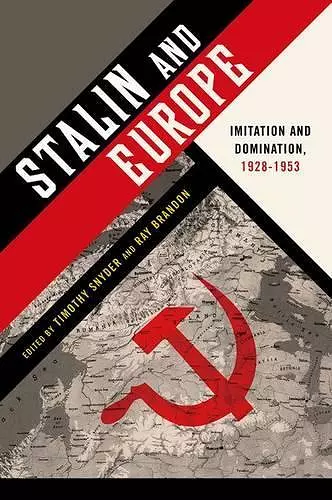Stalin and Europe
Imitation and Domination, 1928-1953
Timothy Snyder editor Ray Brandon editor
Format:Paperback
Publisher:Oxford University Press Inc
Published:10th Jul '14
Currently unavailable, and unfortunately no date known when it will be back
This paperback is available in another edition too:
- Hardback£115.00(9780199945566)

The Soviet Union was the largest state in the twentieth-century world, but its repressive power and terrible ambition were most clearly on display in Europe. Under the leadership of Joseph Stalin, the Soviet Union transformed itself and then all of the European countries with which it came into contact. This book considers each aspect of the encounter of Stalin with Europe: the attempt to create a kind of European state by accelerating the European model of industrial development; mass murder in anticipation of a war against European powers; the actual contact with Europe's greatest power, Nazi Germany, during four years of war fought chiefly on Soviet territory and bringing untold millions of deaths, including much of the Holocaust; and finally the reestablishment of the Soviet system, not just in the reestablished Soviet system, but in the Baltic States, Poland, Czechoslovakia, Romania, Hungary, Bulgaria, and East Germany. The contributors take up not just high politics but also the experiences of the populations that were affected by them. Divided into four parts, the book deals with Soviet politics and actions mainly in the 1930s; the Soviet invasion and occupation of Poland; German aggression against the Soviet Union as well as plans for occupation and their improvised implementation; and Soviet wartime plans for the postwar period. This volume brings together the best work from a multi-year project sponsored by the Institute for Human Sciences in Vienna, including scholars who have worked with archival materials in numerous countries and whose research is often published in other languages.
Stalin and Europe continues a process of reorientation that seeks to incorporate Eastern European and Russian history into European history. The issue of Stalinism and its place in Europe is a particularly treacherous challenge, which this volume resolves in a series of probing essays that explore the Soviet Union's paradoxical relation to the rest of Europe. A diverse group of historians on Germany, Eastern Europe, and the Soviet Union presents the results of voluminous, recent research on the subject. They are an important reminder, and provide ample food for thought, on Russia as a force in European history. * Michael Geyer, University of Chicago *
I read this fascinating, lively collection through from beginning to end in one sitting. That speaks highly for the quality and the challenges that each of the pieces offers. The contributions are primarily from top national and international experts in the field, including a number of rising stars and scholars from Central Europe. All of the essays are grounded in the archives and based on original research. The volume features a variety of methods, perspectives, and approaches, from newer social history to more traditional military and diplomatic history. The collection as a whole reminds us of the seamless transition from the 1930s in the Soviet Union, into war and conquest, and on into the Cold War. * Robert Gellately, author of Stalin's Curse: Battling for Communism in War and Cold War *
ISBN: 9780199945580
Dimensions: 231mm x 155mm x 28mm
Weight: 454g
352 pages